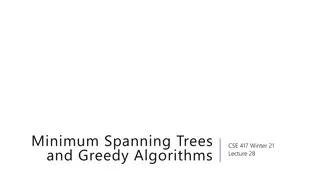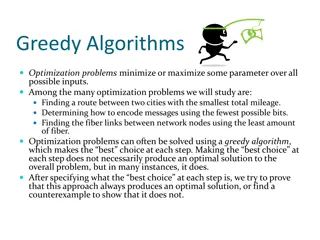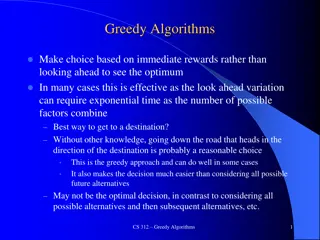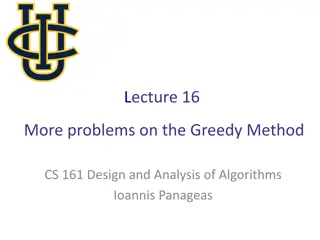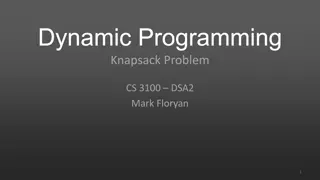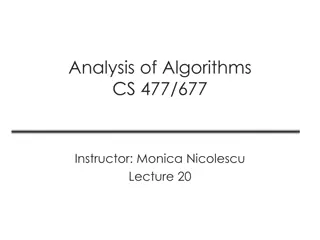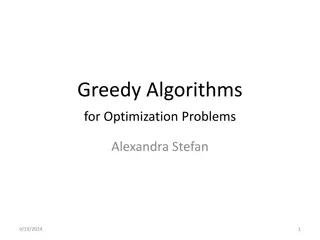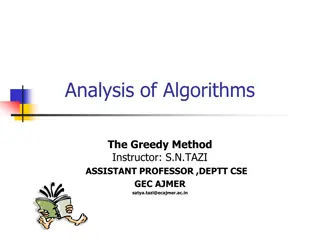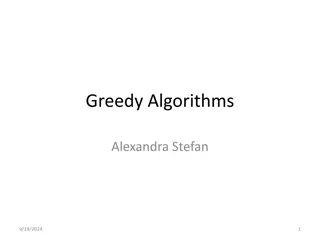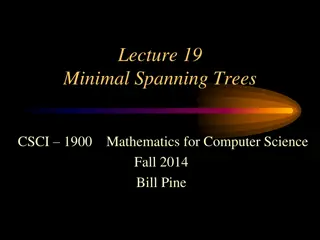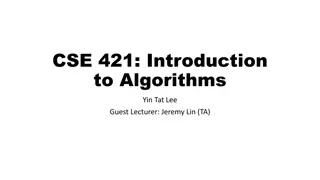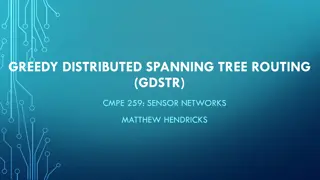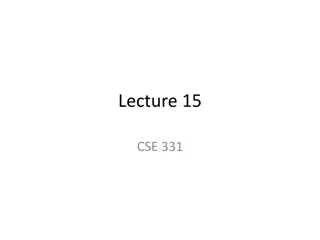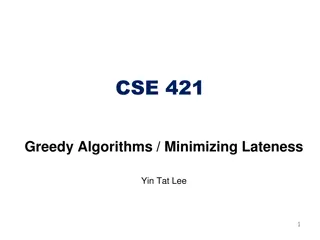Greedy Algorithms: Minimum Spanning Tree Analysis
Explore the concept of Minimum Spanning Tree (MST) in the context of greedy algorithms, focusing on Kruskal's Algorithm. Understand the methodology behind selecting the minimum weighted subgraph that connects all vertices in a weighted graph efficiently. Delve into problem-solving strategies and approaches for optimizing spanning tree selection in algorithms.
Download Presentation

Please find below an Image/Link to download the presentation.
The content on the website is provided AS IS for your information and personal use only. It may not be sold, licensed, or shared on other websites without obtaining consent from the author.If you encounter any issues during the download, it is possible that the publisher has removed the file from their server.
You are allowed to download the files provided on this website for personal or commercial use, subject to the condition that they are used lawfully. All files are the property of their respective owners.
The content on the website is provided AS IS for your information and personal use only. It may not be sold, licensed, or shared on other websites without obtaining consent from the author.
E N D
Presentation Transcript
CSC3160: Design and Analysis of Algorithms Week 3: Greedy Algorithms Instructor: Shengyu Zhang 1
Content Two problems Minimum Spanning Tree Huffman encoding One approach: greedy algorithms 2
Example 1: Minimum Spanning Tree 3
MST: Problem and Motivation Suppose we have ? computers, connected by wires as given in the graph. Each wire has a renting cost. We want to select some wires, such that all computers are connected (i.e. every two can communicate). Algorithmic question: How to select a subset of wires with the minimum renting cost? Answer to this graph? 4 1 4 3 6 2 2 4 5 2 3 3 2 4
More precisely Given a weighted graph ?, we want a subgraph ? = ?,? ,? ?, s.t. all vertices are connected on G . total weight ?,? ? ?(?,?) is minimized. Observation: The answer is a tree. Tree: connected graph without cycle Spanning tree: a tree containing all vertices in ?. Question: Find a spanning tree with minimum weight. The problem is thus called Minimum Spanning Tree (MST). 4 1 4 3 6 2 2 4 5 2 3 3 2 5
MST: The abstract problem Input: A connected weighted graph 4 1 ? = (?,?), ?:? . Output: A spanning tree with min total weight. A spanning tree whose weight is the minimum of that of all spanning trees. Any algorithm? 4 3 6 2 2 4 5 2 3 3 2 6
Methodology 4: Starting from a nave solution See whether it works well enough If not, try to improve it. A first attempt may not be correct But that s fine. The key is that it ll give you a chance to understand the problem. 7
What if Im really stingy? I ll first pick the cheapest edge. I ll then again pick the cheapest one in the remaining edges I ll just keep doing like this as long as no cycle caused until a cycle is unavoidable. Then I ve got a spanning tree! No cycle. Connected: Otherwise I can still pick something without causing a cycle. Concern: Is there a better spanning tree? 6 1 5 3 6 2 4 5 6 4 4 4 2 8
Kruskal's Algorithm What we did just now is Kruskal s algorithm. Repeatedly add the next lightest edge that doesn't produce a cycle in case of a tie, break it arbitrarily. until finally reaching a tree --- that s the answer! 9
Illustrate an execution of the algorithm At first all vertices are all separated. Little by little, they merge into groups. Groups merge into larger groups. Finally, all groups merge into one. That s the spanning tree outputted by the algorithm. 6 1 5 3 6 4 2 5 6 4 4 4 2 10
Correctness: prove by induction Proof plan: We will use induction to prove that at any point of time, the edges found are part of an MST. At any point of time, we ve found some edges ? ?, ? connects vertices into groups ?1, ,??. By induction, ? belongs to some MST ?. ?1 ?2 11
Correctness: prove by induction Suppose Kruskal s algorithm picks ? in the next step, connecting, say, ?1 and ?2. If ? ?, done. If ? ?, adding ? into ? would produce a cycle. The cycle must cross the cut (?1,? ?1) via at least one other edge ?. Since ? is the lightest one among all crossing edges, ? ? ?(?). Let ? = ? ? + ? , then ? ? ?(?). ? is also a spanning tree. Connected, and has ? 1 edges. So ? is also an MST. Induction step done. ? ?1 ?2 ? 5 12
Implementing Kruskal's Algorithm: Initialization: Sort the edges ? by weight create {?} for each ? ? ? = {} for all edges ?,? ?, in increasing order of weight: if adding (?,?)doesn t cause a cycle add edge (?,?) to ? Question: What s not clearly specified yet? 13
Implementation What do we need? We need to maintain a collection of groups Each group is a subset of vertices Different subsets are disjoint. For a pair (?,?), we want to know whether adding this edge causes a cycle If ? and ? are in the same subset now, then adding (?,?) will cause a cycle. Also true conversely. So we need to find the two subsets containing ? and ?, resp. If no cycle is caused, then we merge the two sets containing ? and ?. 14
Data structure Union-Find data structure for disjoint sets find(?): to which set does ? belong? union(?,?): merge the sets containing ? and ?. Using this terminology, let s re-write the algorithm and analyze the complexity 15
Kruskal's Algorithm: rewritten, complexity Initialization: Sort the edges ? by weight create {?} for each ? ? ? = {} for all edges ?,? ?, in increasing order of weight: if find(?) find(?) add edge (?,?) to ? union(?,?) How many finds? - ?(|?| log|?|) - ?(|?|) - ?(1) - 2*cost-of-find - ?(1) - cost-of-union 2|?| How many unions? |?| 1 Total: ?(|?|log|?| + |?| + |?| find-cost +|?| union-cost) 16
data structure for union-find We have used various data structures: queue, stack, tree. Rooted Tree is good here It s efficient: have/cover ? leaves with only log?? depth where ? is the number of children of each node. Each tree has a natural id: the root We now use a tree for each connected component. find: return the root So cost-of-find depends on height(tree). Want: small height. union: somehow make the two trees into one The union cost depends on implementation 17
union Recall: a tree is constructed by a sequence of union operations. So we want to design a union algorithm s.t. the resulting tree is short the cost of union itself is not large either. A natural idea: let the shorter tree be part of the higher tree Actually right under the root of the higher tree To this end, we need to maintain the height information of a tree, which is pretty easy. 18
Details for union(?,?): ??= find(?) ??= find(?) if ??? ? ?? < ??? ? ??: ??????(??) = ?? ?? ?? ? ? ???? ??????(??) = ?? if ??? ? ?? = ??? ? ?? ??? ?(??) = ??? ?(??) + 1 19
How good is this? How high will the resulting tree be? [Claim] Any node of height has a subtree of size at least 2 . Height of node ?: height of the subtree under ?. size: # of nodes Proof: Induction on . The height increases (by 1) only when two trees of equal height merge. By induction, each tree has size 2 , now the new tree has size 2 2 = 2 +1. Done. Thus the height of a tree at any point is never more than log|?|. So the cost of find is at most log|?|. And thus the cost of union is also O log ? 20
Cost of union? ??= ????(?) ??= ????(?) if ??? ? ?? > ??? ? ??: ??????(??) = ?? else ??????(??) = ?? if ??? ? ?? = ??? ? ?? ??? ?(??) = ??? ?(??) + 1 Total cost of union: ?(log|?|). Total cost of Kruskal's algorithm: ?(|?|log|?| + |?| + |?| find-cost +|?| union-cost) = ?(|?|log|?| + |?| + |?|log|?| + |?|log|?|) = ?(|?|log|?|). - ?(log|?|) - ?(log|?|) - ?(1) - ?(1) -?(1) 21
Dont confuse the two types of trees Type 1: (parts of) the spanning tree Red edges 6 1 5 3 6 4 2 Type 2: the tree data structure used for implementing union-find operations Blue edges 5 6 4 4 4 2 22
Question? Next: another MST algorithm. 23
Next: another MST algorithm In Kruskal s algorithm, we get the spanning tree by merging smaller trees. Next, we ll present an algorithm that always maintains one tree through the process. The size of the tree will grow from 1 to |?|. The whole algorithm is reminiscent of Dijkstra s algorithm for shortest paths. 24
Execution on the same example We first pick an arbitrary vertex ?1 to start with. Maintain a set ? = {?1}. Over all edges from ?1, find a lightest one. Say it s (?1,?2). ? ? {?2} Over all edges from {?1,?2} (to ? {?1,?2}), find a lightest one, say (?2,?3). ? ? {?3} In general, suppose we already have the subset ? = {?1, ,??}, then over all edges from ? to ? ?, find a lightest one (??,??+1). Update: ? ? {??+1} Finally we get a tree. That s the answer. v9 v1 6 1 v2 5 3 6 2 4 v8 v3 5 v6 6 4 4 4 v5 v4 2 v7 25
Key property Currently we have the set ?. We want to main the following property: The edges picked form a tree ?? in ? The tree ?? is part of a correct MST ?. When adding one more node from ? ? to ?, we want to keep the property. Question: Which node to add? Recall Methodology 2: Good properties often happen at extremal points. Finally, ? = ?, thus the property implies that our final tree is a correct MST for ?. v1 6 v2 6 4 v3 6 v5 v4 ? ? ? 26
Key property: ?? is part of a MST ?. Consider all edges from ? to ? ?: We pick the lightest one ? (and add the end point in ? ? to ?). Will show: ?? {?} is part of some MST. By induction, a MST ? containing ??. If ? contains ?, done. Else: adding ? into ? produces a cycle. The cycle has some other edge(s) ? crossing ? and ? ?. Replacing ? with ? : Removing any edge in the cycle makes it still a spanner tree. ? is only better: ? ? ?(? ) 6 ? 6 ? 4 6 ? ? ? 27
Prims algorithm Implementation: Very similar to Dijkstra s algorithm. Now the cost function for a vertex ? in ? ? is the minimal weight ?(?,?) over all ? ?. Details omitted; see textbook. Complexity: also ?(|?|log|?|) if we use binary min-heap as before. ?(|?| + |?|log|?|) if Fibonacci heap is used. 28
Extra: Divide and Conquer? Consider the following algorithm: Divide the graph into two balanced parts. About ?/2 each. Find a lightest crossing edge ? 6 6 4 6 ? = ? + {?} Recursively solve the two subgraphs. Is this correct? ? ? ? 29
Huffman encoding Suppose that we have a sequence ? of symbols ?1,?2, ,??. Each ??comes from an alphabet ? of size?. e.g. ? = (?,?,?,?,?,?,?,?), ? = ?,?,?,? . The symbols ?1,?2, ,?? in ? appear in different frequencies ?1,?2, ,??. ??: the number of times ?? appears in ?. In earlier example: ?1= 2,?2= 3,?3= 1,?4= 2. Goal: encode symbols in ? s.t. the sequence ? has the shortest length. 31
Example = ?,?,?,? ,? = 4. ?1= 20,?2= 10,?3= 5,?4= 5. Naive encoding: ? 00,? 01,? 10,? 11. Number of bits: 20 + 10 + 5 + 5 2 = 80. Consider this: ? 0,? 11,? 100,? 101. Number of bits: 20 1 + 10 2 + 5 3 + 5 3 = 70. 32
Requirement for the code The length can be variable: different symbols can have codeword with different lengths. Prefix free: no codeword can be a prefix of another codeword. Otherwise, say if the codewords are ? 0,? 01,? 11,? 001 then 001 is ambiguous It can be either ?? or ?. Question: How to construct an optimal prefix-free code? 33
Prefix-free code and binary tree ? 0,? 11,? 100,? 101 Optimal prefix-free code a full binary tree. Full: each internal node has two children. symbol leaf. Encoding ??: the path from root to the node for ?? Decoding: Follow path to get symbol. Return to the root. 0 1 1 0 A 0 1 B C D Path: represented by sequence of 0 s and 1 s. 0: left branch. 1: right branch 34
Optimal tree? Recall question: construct an optimal code. Optimal: the total length for ? is minimized. New question: How to construct an optimal tree ?. Namely, find min????(?), where ???? ? = ???? ? ?? ?:???? Recall Methodology 3: Analyze properties of an optimal solution. 35
In an optimal tree [Fact] The two symbols ??,?? with the smallest frequencies are at the bottom, as children of the lowest internal node. Otherwise, say ??isn t, then switch it and whoever is at the bottom. This would decrease the cost. This suggests a greedy algorithm: Find ??,?? with the smallest frequencies. Add a node ?, as the parent of ??,??. Remove ??,?? and add ? with frequency ??+ ??. Repeat the above until a tree with ? leaves is formed. 36
Algorithm, formal description Input: An array ?[1, ,?] of frequencies Output: An encoding tree with ? leaves let ? be a priority queue of integers, ordered by ? for? = 1 to ? insert(?,?) for ? = ? + 1 to 2? 1 ? = delete-min(?); ? = delete-min(?) create a node numbered ? with children ?,? ? ? = ? ? + ? ? insert(?,?) 37
On the running example ?1= 20,?2= 10,?3= 5,?4= 5. ?1= 20,?2= 10,?5= 5 + 5 = 10. ?1= 20,?6= 10 + 10 = 20. ?7= 20 + 20 = 40. 0 1 40 1 0 A:20 20 0 1 B:10 10 C:5 D:5 Final cost: 20 1 + 10 2 + 5 3 + 5 3 = 70 Also: = ?:non root nodenumber for ? Including both leaves and internal nodes, but not root. 38
Summary We give two examples for greedy algorithms. MST, Huffman code General idea: Make choice which is the best at the moment only. without worrying about long-term consequences. An intriguing question: When greedy algorithms work? Namely, when there is no need to think ahead? Matroid theory provides one explanation. See CLRS book (Chapter 16.4) for a gentle intro. 39

 undefined
undefined




